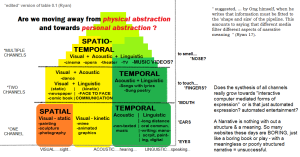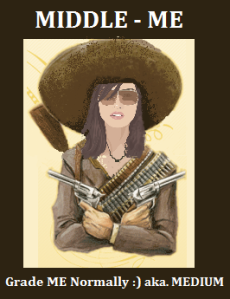To be graded: Medium
What are Media?
-Marie-Laure Ryan
a channel or system of communication, information, or entertainment
material or technical means of artistic expression
these vague medium definitions are referred to as “sense 1” and “sense 2” in the reading. But don’t worry, if simple and easy isn’t your cup of tea, Ryan goes way too into detail about pinpointing exactly what medium is. The point is made that the mediums included in sense 1 are usually merely a means to communicate “messages” of a sense 2 medium. for example, an oil painting, must be oil on canvas, before it can be a digital image sent through the computer. a movie must be on film, before being transmitted through your television. To me it seems odd that the two definitions of medium according to Webster’s Dictionary are really connected in such a way.
Ryan points out that for many instances of art or “messages”, the medium is more then just something to deliver upon. considering the cinema, she points out that there isn’t recording of artistic objects in their own right. What is recorded is a staging of action done for the sole purpose of being filmed. Only once the film is edited and processed is the message formed. she gives this example and another as a way of explaining the existence of the two definitions of medium and how they can both be right.
The focus the brings to the front, is exploring media in terms of their narrative power. She uses the word “mediality” or “mediumhood” as a relational property, that is used in comparing mediums, seeing if one offers different narrative possibilities than another. In comparing the invention and use of the newspaper to books, some historians would argue that the narratives they offer are for the most part the same. But there are ways in which newspaper differ, in terms of how the narrative is written, how often it must be provided/updated or changed, and how daily reports can sometimes lack certain complete qualities of other narratives. It is with this comparison that a distinction be made between genre and medium.
The difference according to Ryan, is in the constraints and limits medium put on the writer. Genre, she defines more or less as adopted conventions, chosen for personal/cultural reasons. Where as Medium’s limitations are imposed on the user, restricting and shaping the narrative accordingly. while rules dictated by genre are done so to purposefully shape the narrative, the walls put up by media are not put up with the user’s intentions in mind. thus, the user must work around or try to ignore/fight the narrative obstacles that media place down.
ultimately its a thin line between genre and medium, and you can choose to accept whichever defining characteristics about each that you want. Ryan goes on to attempt go provide her own classifications of medium in a wordy explanation/train of logic that i unfortunately have trouble following clearly. so ill end my post here.


